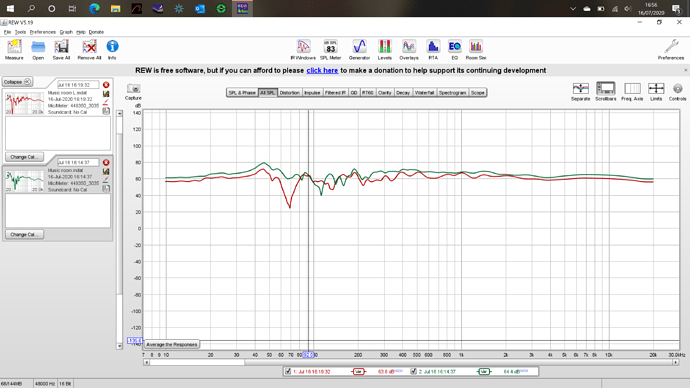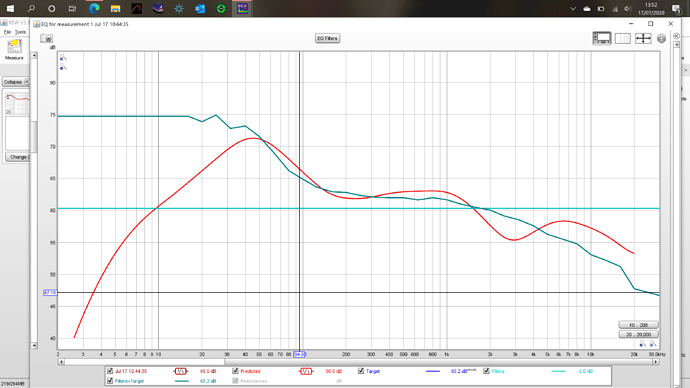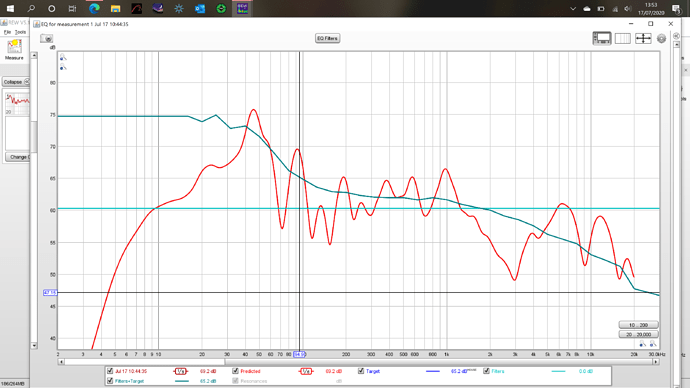OK  will try
will try
So having had the acoustics guy in this is where he’s managed to get the room to without any panels or other treatment - just placing the speakers and setting the sub by ear. And honestly, it now sounds so good I am not sure whether to mess around with convolution files etc.
Turns out the guy is a bit of a genius when it comes to sorting room acoustics out having worked on a host of recording studios and most super-clubs worldwide. Was nice to have him round to sort out my modest little room 
I listen to a good chunk of vinyl as well so having the room well set up means it sounds good regardless of source. May give one a go though just because I can :).
@dannybgoode
Got a good bit smoother, but the coarse scaling is deceptive here.
There’s still almost a 20dB fall from the low bass room mode to the upper bass to lower midrange average level, and then almost 10 dB of a rise thereafter.
I strongly encourage you doing the REW shuffle and whipping up some convolution files! And if your room layout is not symmetrical, do separate filters for left and right channels.
The improvement, again, will blow your mind, I guarantee you!
The room was tuned with me in it and listening to an hour or so of music and honestly it works for me just fine. It’s been set up for my sonic taste as it is.
I may mess around with convolution because I can but I have no pressing desire to
And sorry should have said that is the left and right traced just the room as it is
Hey, everything’s fine that makes you happy!
No pressing from my side…enjoy!
I’ll have a play for sure because I can however the room was tuned for how I like music to sound. The whole idea in the first place was to mess with such things after all. It was only when asking for help on how to interpret the results did I get this guy recommended to me and he has done a solid job just working with what I already have.
I have already applied a ‘perfect’ convolution file (flat, no house curve etc) and found it too bright at the top end which is exactly what we tuned out. I suspect that if I play with a bit of EQ I’ll just end up back where I am with no convolution 
That dip in red is gigantic, luckily its at 70Hz and you have no dip in other channel so it won’t matter that much (you don’t hear direction of 70Hz, at least not very good). The main thing I would correct is to raise the 70-250 area, it is a few dB to low which will lead to music sounding a little less warm.
A flat correction will sound bright and thin, that’s why you have a house curve. It has to do with how the ear perceive sound and frequencies (we hear higher frequency as louder than lower frequency with the same volume).
Bit of a cut and paste from another forum this as I’ve been discussing the same thing but to give you an idea of what the process was with the acoustics guys. This was also my first attempt in measuring with REW so my technique may be a bit off as well  . Doubt it would make a huge amount of difference but I didn’t use your spiral method hear rather just pointed the mic at the speakers.
. Doubt it would make a huge amount of difference but I didn’t use your spiral method hear rather just pointed the mic at the speakers.
We spent a good two hours listening to my music in the room though and discussing what I liked and did not like about the sound with Mike & Nico fettling until it sounded right to me. Not what measured right or what they thought was the ideal; it was about how I liked things. I have absolutely no doubt that had I instructed them to make the room measure flat they would have done so, albeit perhaps that would have necessitated either some form of DSP and/or panels etc.
To me my system now sounds pretty much perfect - I don’t find it lacking warmth, it’s just beautifully balance to my ear. The dip is interesting and is something to do with the big wardrobe but don’t ask me to explain what!
For completeness I have done a combined L&R measurement 1/6 smoothed and overlaid over a ‘perfect’ house curve and also against a completely flat response as well as a 1/1 smoothed one. Note a perfectly flat response sounds pretty horrid to me - I have tried it using a convolution file and HQP - and it is pretty common for people to dislike a perfectly flat response hence the development of the so called ‘house curve’ which. I felt an L&R combined measurement pertinent as the reflections from both speakers together interact with each other.
The pale blue line is a flat response and the dark blue/turquoise line is the theoretical house curve and the red my measurements
The first graph is with my REW graph averaged to 1/1 octave which is the overall mean output from the speakers, the second is 1/6 smoothing to compare directly with the separate L&R graphs previously. The curve I used is the Harman curve and is available here for anyone that is interested - Harman Curve
The 1/1 smoothed one pretty much follows the ‘ideal’ perfectly. Sure I could tweak a bit with a convolution file but given I use other sources than digital it is nice having the room largely sorted.
Great guide! Tack @Magnus!
Would be wonderful with a REW integration into Roon. Any thoughts about this @danny? Maybe something to put on the roadmap? Like automatic transfer of convolution files to core and Roon as playback for test sounds. 
Since Roon supports convolution files directly from REW, I think the next step is to add full support for room correction in Roon (measurement, create filters etc). Even if it only handled frequency adjustment it would be a great help if the GUI was easy to use, like for example Dirac step-by-step guide (REW is not exactly easy to get into).
Or maybe a Dirac integration with a one-time cost for “Dirac Roon edition” which would enable Dirac and Roon to work together seamlessly (as opposite to Roon and Dirac today).
Hi dannybgoode, could you describe the type of optimizations the acoustics expert did for you that worked?
Was it for example speakers placement “radical” type of changes (moving them more than 50cm) or “fine tuning” (couple of cm which several people claim have significant effect)?
Thx
I had got it pretty good already so it was minor changes and also tuning the sub to integrate much better.
There’s a lot of furniture in the room including a rather large wardrobe which was causing issues so it was a case of manipulating the modes and dips to counteract each other through repositioning.
It was an interesting process; a couple of hours of listening to my music as adjustments were made until I was happy. I could have ending up at a similar point through trial and error by having someone there who does this for a living made the whole process quicker.
That’d be a paradigm shift for Dirac: their entire model is based on a per-location license. There’s also the question of what their deal is with automakers, and user experience consistency: with the (hopefully, eventually) upcoming Roon-on-the-go, how do you deal with users who wouldn’t understand why they can’t use their nice and expensive Dirac license in their car ? Finally, there’s the, let’s say, aloofness : while @flak offered a way around Dirac’s limitations with the VST suggestion, which is great and exactly what one’d expect from a coms guy, he not only (and very admittedly) didn’t take the time to actually look at ROCK in-depth before answering, but also didn’t seem to care to address the specificities of the different products. It’s great for them that their business is so vibrant they can ignore a platform with tens of thousands of users, and a disappointing conclusion for Roon users, but given what we’ve seen, it’d seem like the logical conclusion is that Dirac consider that they’re on top of the world and that Roon are the ones who should come kiss the ring, and thus that everyone’s best interest would be better suited by NOT pushing for Dirac-Roon-Edition.
It was just a spur of the moment idea, maybe Dirac and Roon will never marry. But you also have Audiolense and Acourate. There are even open-source solutions with correct handling of time-domain corrections (but I forgot the name).
Personally I don’t like the way Roon seems to be going the last years, towards mainstream and away from focus on sound quality and sound quality features.
Completely agreed. There’s a couple of other higher-end, closed-source solutions which might make good candidates as well (Trinnov is one, Illusonic another), and there’s certainly other stuff. One of the things that Roon has going for it is that you essentially have unlimited computing power. Assuming it’s of use, I don’t see how it wouldn’t be imaginable to have it quickly generate a good but not as good as can be filter, and then transparently do heavy math in the background over a few days to hone the result into something that’d be better than what a normal person would bear waiting in front of their screen to get, for example.
Most of whats needed is in Roon already (but maybe not as good as it could be). DRC in Roon could for example be something like this:
- Measuring window in Roon, allows sweep measures or RTA moving mic measures
- A window for designing house curve, with a good H&K alike house curve as default.
- Generate PEQ filters from measurement and house curve
- Allow user to fine tune the PEQ while listening
- Once user is happy with result, generate and use a convolution file for normal listening
This would basically cover what I have in this guide, but much easier and without external software. If time domain corrections are involved, it could also produce better results than this guide does. And 3-5 is (more or less) already in place in Roon.
One thing that Roon needs though is a PEQ and convolution engine that sounds better. I have compared same convolution in Roon and in HQPlayer and HQPlayer does produce better sound quality but with more latency (the difference is very noticeable on a transparent HiFi system).
I just tried the latest beta from REW, and it seems auto-correct has changed to the better. Much fewer filters used now. It can still go a little crazy at the higher frequency but that can easily be corrected manually.
On a related note, if you want to lower or raise treble, I have had good success with a filter at 20khz with Q value or 0.1 to 0.2 and a few dB up or down. It gives a nice smooth slope that ends at around 1-2Khz (depending on Q) and does not seem to give any changes in sound quality except the wanted change in treble.
Chris - do you know of any that can do this stuff for you? Like use Acourate or something similar and get the best result in your room? Makes sense to those that don’t have any experience in this area.


